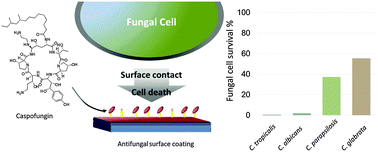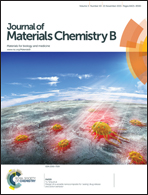Surface coatings with covalently attached caspofungin are effective in eliminating fungal pathogens†
Abstract
In this work we have prepared surface coatings formulated with the antifungal drug caspofungin, an approved pharmaceutical lipopeptide compound of the echinocandin drug class. Our hypothesis was to test whether an antifungal drug with a known cell-wall disrupting effect could be irreversibly tethered to surface coatings and kill (on contact) biofilm-forming fungal human pathogens from Candida spp. The first aim of the study was to use surface analysis to prove that the chemical binding to the surface polymer interlayer was through specific and irreversible bonds (covalent) and not due to non-specific adsorption through weak forces that could be later reversed (physisorption). Secondly, we quantified the antifungal nature of these coatings in a biological assay showing excellent killing against C. albicans and C. tropicalis and moderate killing against C. glabrata and C. parapsilosis. We concluded that caspofungin retains antifungal activity even when it is irreversibly immobilized on a surface, providing a new insight into its mechanism of action. Thus, surface coatings that have echinocandins permanently bound will be useful in preventing the establishment of fungal biofilms on materials.


 Please wait while we load your content...
Please wait while we load your content...